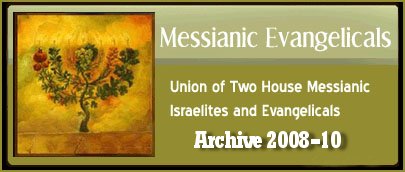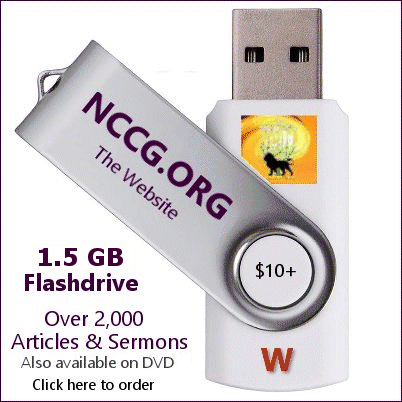RESOURCES
5-144000
A
B
C
D
E
F
G
H
I
J
K
L
M
N
O
P
Q
R
S
T
U
V
W
Y
Z
|
|

|
Tongues - A Messianic Perspective
Posted by Lev/Christopher on November 2, 2008 at 1:42am
in Tongues
www.nccg.org/tongues
Please listen to this excellent and vitally important lecture on tongues at: http://www.coyhwh.com/
Select > AUDIO, scroll down and download > GIFT OF LANGUAGES
DON'T BE DECEIVED BY THE CHARISMATIC NEW AGE DECEPTION!
Therefore My people are gone into captivity, because they have no knowledge - Isaiah 5:3
History of Pentecost
History of Pentecost
Pentecost, the Feast of Weeks, and the Day of the Firstfruits, are three names for the same Festival.
It is called Pentecost (Acts 2:1) – meaning fiftieth, because it is the fiftieth day of Counting the Omer:
Lev 23:15-16 - "You shall count for yourselves . . . from the day when you brought the omer of the Wave Offering . . . fifty days . . . then you shall present a new grain offering to Yahweh."
An omer is a tithe of an ephah (Ex 16:36), or a dry measure of approximately one-half gallon (an ephah being about a bushel). On the first day of Counting the Omer, "an omer of barley from tender ears" (Talmud: Sanhedrin 11b) was baked into unleavened bread and waved with a lamb before Yahweh (a name of God representing the Eternal Who is Gracious and Merciful). Since this was during the Feast of Unleavened Bread, no leaven was permitted. Barley was the first grain crop to ripen, followed by spelt, rye, oats, and finally wheat. Each day was verbally counted, with a blessing offered to God. When the full verbal count of fifty days was reached, "when the Day of Pentecost was fully come" (Acts 2:1), then two leavened loaves (each about three feet long and nine inches wide) were waved before Yahweh; each loaf was made from two omers (about a gallon) of fine wheat flour.
Lev 23:17 - "You shall bring out of your habitations two wave loaves of two omers: they shall be of fine flour; they shall be baked with leaven; they are the firstfruits unto Yahweh."
It is called (Heb.) Hag Shavuot / Feast of Weeks (Ex 34:22), because the days of tithing grain are counted for seven weeks, plus one day:
Lev 23:16 - "You shall count fifty days, to the day after the seventh week."
It is called (Heb.) Yom haBikkurim / Day of the Firstfruits (Num 28:26), because it is the day when the final tithes (represented by omers of flour) of the grain harvest are brought. These tithes are part of what is called firstfruits. After waving the firstfruits of new wheat, the new wheat crop may be used for consumption.
Num 28:26 - "Also on the Day of the Firstfruits, when you present a new grain offering to Yahweh in your Feast of Weeks, you shall have a holy convocation; you shall do no laborious work."
Almost 4000 years ago,1
on the Day of Firstfruits (Talmudic), God divided the world into seventy languages at Babel. This is commonly known as the Dispersion. Genesis 10 names the seventy nations, and Genesis 11:1-9 describes the division of languages. It is understood in Orthodox circles that God kept the firstfruits – the line of Abraham (who was about 48 at this time), and the rest of the world had their languages changed.
Then about 3500 years ago,2 on another Day of Firstfruits, at Mt. Sinai, God gave the Torah to Israel as a Betrothal Covenant.3 Talmud: Shabbat 88b on Psalm 68:11 teaches that "Every single word going out from the Omnipotent was split up into seventy languages." Psalm 29:7 reads, "The voice of Yahweh hews out tongues of fire." It was understood by Jewish folk of 2000 years ago, that a "tongue as fire" had presented itself to each person at Sinai, to ask if he would accept the Covenant. Those present were from all seventy nations, a "mixed multitude."
Then, at still another Pentecost about 1970 years ago (around AD 30),4 the people at Jerusalem experienced something they were taught had happened prevoiusly, at the Pentecost at Sinai: God partially reversed Babel – granting some of His Hebrew speaking saints to miraculously proclaim the gospel in these various languages of the world, which again came as "tongues as fire". It was serious language that burnt. Hear the words that were spoken: "Men of Israel, listen to these words: Yeshua the Nazarene, a man attested to you by God with miracles and wonders and signs which God performed through Him in your midst, just as you yourselves know – this Man, delivered up by the predetermined plan and foreknowledge of God, you nailed to a cross by the hands of godless men and put Him to death. But God raised Him up again, putting an end to the agony of death, since it was impossible for Him to be held in its power" – (Acts 2:22-24). This grant of hearing the Gospel in one’s own language prefigured the future complete reversal of Babel – the restoration of a common language.
Today, at the Feast of Pentecost, we celebrate the Betrothal in a similar fashion to the ancients. Fifty days prior, at the Passover seder, we take four cups of wine/grape juice, representing the four parts of the Covenant, recognizing God's redemption of a slave girl (Israel) to be Messiah's bride. Now, at the betrothal ceremony, we take the Bride's Cup, saying, "Whatever our Lord speaks, we will obey, and we will listen (learn)" – Ex 24:7. Note that we are to obey God even before we learn why. The leader of the Festival then proclaims, "Thy maker is thine husband; Yahweh of Hosts is His name; and thy Redeemer the Holy One of Israel; the God of the Whole Earth shall He be called" – Isaiah 54:5. Note: a betrothed couple is called husband and wife, even before the wedding, when there is no cohabitation.
For an overview of the Biblical Festivals and their Messianic significance, see Festival Overview. For more detail on the Feast of Pentecost, see Feast of Firstfruits and Pentecost Seder.
Languages of Men and Angels, Prayer Language
The term "angel" means messenger. It is a common reference to heavenly beings who are messengers of God. Within Judaism, it is also an ancient common reference to an officer of the synagogue: the (Heb.) Sheliach Tzibbur / Messenger of the Congregation or (Gr.) Angeloi tas Ekklesias / Angel of the Church, as used in Revelation 2 & 3, brought messages from the Holy Temple or from prophets to the congregation.
For several millennia, the "Language of Angels" has been understood to be Hebrew. This applies to both heavenly angels and earthly messengers. Wherever God or a heavenly angel is said to have spoken specific verbiage, the quoted language is Hebrew. (Note Acts 26:14.) Hebrew was and is believed to be the Holy Language by which God created the universe, the language of Eden, and the basis of all other languages: for an Orthodox explanation, see www.homestead.com/edenics/ . Also, the "Angel of the Church," when bringing a message from the Holy Temple or from a prophet, always brought the message in the Holy Tongue – Hebrew. Talmud: Shabbat 40b reads, "Secular matters may be uttered in the Holy Language (Hebrew), but sacred matters must not be uttered in a secular language."
The "languages of men" represent the other languages (and their derivatives) of the seventy nations that resulted from the dispersion from Babel, where God divided the earth by languages.
"Prayer Language" has also historically been understood to be Hebrew. Hebrews, to this day, generally pray in the Hebrew tongue regardless of their native language (usually starting: "Baruch Atah . . ." / Blessed are You . . .).
Glossalalia
Today's "speaking in tongues," with its companion, "interpretation," has an interesting history. This same charismatic glossalalia was "experienced" by occultists long before Christianity: it did not originate 1970 years ago at Pentecost. It is still widely practiced by non-believers. It has been adopted and promoted within modern Christendom by novel new interpretations of Scripture: in 1901, Neo-Pentecostalism began with Charles Parham and Agnes Ozman's experience. For a chronology of the recent adoption of glossalalia, see www.watch.pair.com/chronology.html For a history of the practice, see www.apologetique.org/en/rticles/neomontanism/BDG_glossolalia_en.htm .
For the past century, many professing Christians have practiced glossalalia, calling it "speaking in tongues" in an attempt to tie their "experience" to Biblical wording. "Other tongues" is an Old English term that in Modern English would be rendered "foreign languages"; the Old English term is often used for mystique. More current terminology would make modern misuse more difficult: the term "foreign languages" may easily be seen to represent the ancient understanding of "the languages of the nations," used in contrast to the Holy Language – Hebrew.
Some advertise their practice to show themselves more spiritual, even making the anti-Biblical claim that others "don't have the Holy Spirit," or making the provocative claim that others are "limiting the power of God." Many Christians accept the beliefs of charismatics, because they are unwilling to cast doubt on their friends, or because they trust in certain teachers.
But, the bottom line is, glossalalia is not the Biblical "speaking in foreign languages" of the nations, and it is not speaking in the Biblical "Language of Angels" or prayer language, both being Hebrew.
Extreme caution is warranted in speaking for God, since attributing one's utterances to the Holy Spirit, when they are not, is a capital offense in Torah (Deut 18:20). In other words, if we falsely proclaim our words ("tongues" or "interpretations") to be of God, we are worthy of death. A lack of learning the historical basis of the Word of God leaves us open to captivation into false doctrine, even occult practices, as indicated by Isaiah 5:3.
Footnotes
1 AM 1996 (AM = Anno Mundi, / Year of the World) by rabbinic calculation from Scripture.
2 AM 2448 by rabbinic calculation.
3 The Torah was the (Heb.) Shitre Erusin / Betrothal Covenant, not the (Heb.) Ketuvah / Marriage Covenant, these being often confused.
4 AD 30 is based on Yeshua's birth being about 4 BC, and about 33 more years to the crucifixion and subsequent Pentecost. By rabbinic calculation, the Common Era (AD 1) began AM 3762, making the Jerusalem Pentecost about AM 3795; We suggest that the Jerusalem Pentecost might actually have been about 200 years later – closer to AM 4000.
The present year beginning Sept AD 2001 is AM 5762 by rabbinic calculation. We suggest that the present year might actually be about 200 years later – in the last generation of the sixth millennium. For explanation, see Sabbath is Messianic and Millennial Sabbath.
Courtesy of http://www.ahavta.org/tongues.htm
|


This page was created on 5 May 2010
Updated on 5 May 2010
Copyright © 1987-2010 NCCG - All Rights Reserved
|
|


